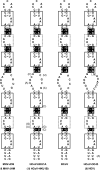New structure model for the packaging signal in the genome of group IIa coronaviruses
- PMID: 17428856
- PMCID: PMC1900089
- DOI: 10.1128/JVI.02231-06
New structure model for the packaging signal in the genome of group IIa coronaviruses
Abstract
A 190-nucleotide (nt) packaging signal (PS) located in the 3' end of open reading frame 1b in the mouse hepatitis virus, a group IIa coronavirus, was previously postulated to direct genome RNA packaging. Based on phylogenetic data and structure probing, we have identified a 95-nt hairpin within the 190-nt PS domain which is conserved in all group IIa coronaviruses but not in the severe acute respiratory syndrome coronavirus (group IIb), group I coronaviruses, or group III coronaviruses. The hairpin is composed of six copies of a repeating structural subunit that consists of 2-nt bulges and 5-bp stems. We propose that repeating AA bulges are characteristic features of group IIa PSs.
Figures



References
-
- Altschul, S. F., W. Gish, W. Miller, E. W. Myers, and D. J. Lipman. 1990. Basic local alignment search tool. J. Mol. Biol. 215:403-410. - PubMed
-
- Hsieh, P.-K., S. C. Chang, C.-C. Huang, T.-T. Lee, C.-W. Hsiao, Y.-H. Kou, I.-Y. Chen, C.-K. Chang, T.-H. Huang, and M.-F. Chang. 2005. Assembly of severe acute respiratory syndrome coronavirus RNA packaging signal into virus-like particles is nucleocapsid dependent. J. Virol. 79:13848-13855. - PMC - PubMed
Publication types
MeSH terms
Associated data
- Actions
- Actions
- Actions
- Actions
- Actions
LinkOut - more resources
Full Text Sources
Research Materials

